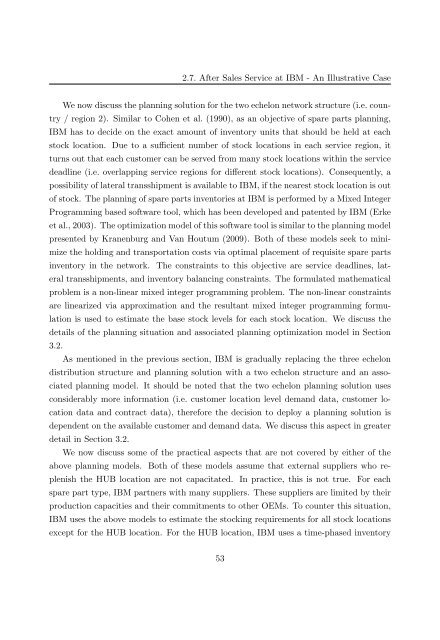Customer Information Driven After Sales Service ... - RePub
Customer Information Driven After Sales Service ... - RePub
Customer Information Driven After Sales Service ... - RePub
You also want an ePaper? Increase the reach of your titles
YUMPU automatically turns print PDFs into web optimized ePapers that Google loves.
2.7. <strong>After</strong> <strong>Sales</strong> <strong>Service</strong> at IBM - An Illustrative Case<br />
We now discuss the planning solution for the two echelon network structure (i.e. coun-<br />
try / region 2). Similar to Cohen et al. (1990), as an objective of spare parts planning,<br />
IBM has to decide on the exact amount of inventory units that should be held at each<br />
stock location. Due to a sufficient number of stock locations in each service region, it<br />
turns out that each customer can be served from many stock locations within the service<br />
deadline (i.e. overlapping service regions for different stock locations). Consequently, a<br />
possibility of lateral transshipment is available to IBM, if the nearest stock location is out<br />
of stock. The planning of spare parts inventories at IBM is performed by a Mixed Integer<br />
Programming based software tool, which has been developed and patented by IBM (Erke<br />
et al., 2003). The optimization model of this software tool is similar to the planning model<br />
presented by Kranenburg and Van Houtum (2009). Both of these models seek to minimize<br />
the holding and transportation costs via optimal placement of requisite spare parts<br />
inventory in the network. The constraints to this objective are service deadlines, lateral<br />
transshipments, and inventory balancing constraints. The formulated mathematical<br />
problem is a non-linear mixed integer programming problem. The non-linear constraints<br />
are linearized via approximation and the resultant mixed integer programming formulation<br />
is used to estimate the base stock levels for each stock location. We discuss the<br />
details of the planning situation and associated planning optimization model in Section<br />
3.2.<br />
As mentioned in the previous section, IBM is gradually replacing the three echelon<br />
distribution structure and planning solution with a two echelon structure and an associated<br />
planning model. It should be noted that the two echelon planning solution uses<br />
considerably more information (i.e. customer location level demand data, customer location<br />
data and contract data), therefore the decision to deploy a planning solution is<br />
dependent on the available customer and demand data. We discuss this aspect in greater<br />
detail in Section 3.2.<br />
We now discuss some of the practical aspects that are not covered by either of the<br />
above planning models. Both of these models assume that external suppliers who replenish<br />
the HUB location are not capacitated. In practice, this is not true. For each<br />
spare part type, IBM partners with many suppliers. These suppliers are limited by their<br />
production capacities and their commitments to other OEMs. To counter this situation,<br />
IBM uses the above models to estimate the stocking requirements for all stock locations<br />
except for the HUB location. For the HUB location, IBM uses a time-phased inventory<br />
53

















